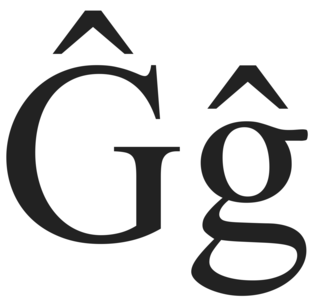Postalveolar affricates are a type of consonant sound. The most common postalveolar affricates are:
Postalveolar affricates are a type of consonant sound. The most common postalveolar affricates are:
An affricate is a consonant that begins as a stop and releases as a fricative, generally with the same place of articulation. It is often difficult to decide if a stop and fricative form a single phoneme or a consonant pair. English has two affricate phonemes, and, often spelled ch and j, respectively.

Ç or ç (C-cedilla) is a Latin script letter, used in the Albanian, Azerbaijani, Manx, Tatar, Turkish, Turkmen, Kurdish, Zazaki, and Romance alphabets. Romance languages that use this letter include Catalan, French, Friulian, Ligurian, Occitan, and Portuguese as a variant of the letter C with a cedilla. It is also occasionally used in Crimean Tatar and in Tajik to represent the sound. It is often retained in the spelling of loanwords from any of these languages in English, Basque, Dutch, Spanish and other languages using the Latin alphabet.
Sibilants are fricative consonants of higher amplitude and pitch, made by directing a stream of air with the tongue towards the teeth. Examples of sibilants are the consonants at the beginning of the English words sip, zip, ship, and genre. The symbols in the International Phonetic Alphabet used to denote the sibilant sounds in these words are, respectively,. Sibilants have a characteristically intense sound, which accounts for their paralinguistic use in getting one's attention.

Ĝ or ĝ is a consonant in Esperanto orthography, representing a voiced postalveolar affricate, and is equivalent to a voiced postalveolar affricate or a voiced retroflex affricate.

Pharyngealization is a secondary articulation of consonants or vowels by which the pharynx or epiglottis is constricted during the articulation of the sound.

A digraph or digram is a pair of characters used in the orthography of a language to write either a single phoneme, or a sequence of phonemes that does not correspond to the normal values of the two characters combined.
In phonetics, palato-alveolar or palatoalveolar consonants are postalveolar consonants, nearly always sibilants, that are weakly palatalized with a domed (bunched-up) tongue. They are common sounds cross-linguistically and occur in English words such as ship and chip.

Che or Cha is a letter of the Cyrillic script.

An apical consonant is a phone produced by obstructing the air passage with the tip of the tongue (apex) in conjunction with upper articulators from lips to postalveolar, and possibly prepalatal. It contrasts with laminal consonants, which are produced by creating an obstruction with the blade of the tongue, just behind the tip. Sometimes apical is used exclusively for an articulation that involves only the tip of the tongue and apicolaminal for an articulation that involves both the tip and the blade of the tongue. However, the distinction is not always made and the latter one may be called simply apical, especially when describing an apical dental articulation. As there is some laminal contact in the alveolar region, the apicolaminal dental consonants are also labelled as denti-alveolar.

The voiceless palato-alveolar sibilant affricate or voiceless domed postalveolar sibilant affricate is a type of consonantal sound used in some spoken languages. The sound is transcribed in the International Phonetic Alphabet with ⟨t͡ʃ⟩, ⟨t͜ʃ⟩ or ⟨tʃ⟩. The alternative commonly used in American tradition is ⟨č⟩. It is familiar to English speakers as the "ch" sound in "chip".

The voiced palato-alveolar sibilant affricate, voiced post-alveolar affricate or voiced domed postalveolar sibilant affricate, is a type of consonantal sound, used in some spoken languages. The sound is transcribed in the International Phonetic Alphabet with ⟨d͡ʒ⟩, or in some broad transcriptions ⟨ɟ⟩, and the equivalent X-SAMPA representation is dZ. Alternatives commonly used in linguistic works, particularly in older or American literature, are ⟨ǰ⟩, ⟨ǧ⟩, ⟨ǯ⟩, and ⟨dž⟩. It is familiar to English speakers as the pronunciation of ⟨j⟩ in jump.
The palato-alveolar ejective affricate is a type of consonantal sound, used in some spoken languages. The sound is represented in the International Phonetic Alphabet with ⟨t͡ʃʼ⟩. In some languages it is equivalent to a palatal ejective.
Tesh may refer to:
The retroflex ejective affricate is a type of consonantal sound, used in some spoken languages. The symbol in the International Phonetic Alphabet that represents this sound is ⟨ʈ͡ʂʼ⟩, though it is frequently simplified to ⟨tʂʼ⟩.
Lembena, also known as Lembena Pii, Nanimba Pii, Uyalipa Pii, or Wapi Pii, is an Engan language spoken in Papua New Guinea.
The voiceless retroflex lateral affricate is a rare consonantal sound, used in some spoken languages. The symbol in the International Phonetic Alphabet is ⟨ʈ͜ɭ̊˔⟩, and in extIPA ⟨ʈꞎ⟩.

The Istanbul Greek dialect is the endangered Greek dialect spoken by the millennia-old Greek community in Istanbul, which has now shrunk to a couple thousand individuals. It is differentiated from Standard Greek due to a number of internal divergent developments, preservation of characteristics of Ancient Greek that are absent from Standard Greek, and Language contact, most notably with Turkish, French, Italian and Armenian. Various characteristics of Istanbul Greek are said to have parallels in Old Athenian Greek, as well as Tsakonian.
The voiced retroflex lateral affricate is a rare consonantal sound, used in some spoken languages. The symbol in the International Phonetic Alphabet is ⟨ɖ͜ɭ˔⟩ and in extIPA ⟨ɖ𝼅⟩.